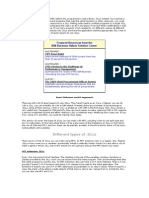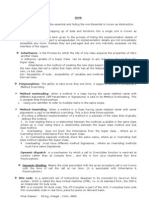0 ratings0% found this document useful (0 votes)
26 views06-DPSI-System Modeling
The document discusses various system modeling techniques including context models, interaction models, structural models, and behavioral models. Context models illustrate the operational context of a system and its relationships with external systems. Interaction models such as use case diagrams and sequence diagrams are used to model user interactions and system communications. Structural models like class diagrams show the organization of a system through its components and relationships. Behavioral models represent the dynamic behavior of a system through techniques like activity diagrams and state transition diagrams.
Uploaded by
adi muhamadCopyright
© © All Rights Reserved
Available Formats
Download as PDF, TXT or read online on Scribd
0 ratings0% found this document useful (0 votes)
26 views06-DPSI-System Modeling
The document discusses various system modeling techniques including context models, interaction models, structural models, and behavioral models. Context models illustrate the operational context of a system and its relationships with external systems. Interaction models such as use case diagrams and sequence diagrams are used to model user interactions and system communications. Structural models like class diagrams show the organization of a system through its components and relationships. Behavioral models represent the dynamic behavior of a system through techniques like activity diagrams and state transition diagrams.
Uploaded by
adi muhamadCopyright
© © All Rights Reserved
Available Formats
Download as PDF, TXT or read online on Scribd
You are on page 1/ 34
System Modeling
Dasar Pengembangan Sistem Informasi
Fajar Pradana S.ST., M.Eng
Topics covered
• Context models
• Interaction models
• Structural models
• Behavioral models
System modeling
• System modeling is the process of developing abstract models of a
system, with each model presenting a different view or perspective
of that system.
• System modeling may represent a system using graphical notation,
e.g. the Unified Modeling Language (UML).
• System modelling helps the analyst to understand the functionality
of the system and models are used to communicate with customers.
System Perspectives
• An context/external perspective
▪ model the context or environment of the system.
• An interaction perspective
▪ model the interactions between a system and its environment, or
between the components of a system.
• A structural perspective
▪ model the organization of a system or the structure of the data that is
processed by the system.
• A behavioral perspective
▪ model the dynamic behavior of the system and how it responds to
events.
Why Use of Graphical Models?
• As a means of facilitating discussion about an existing or proposed
system
▪ Incomplete and incorrect models are OK as their role is to support
discussion.
• As a way of documenting an existing system
▪ Models should be an accurate representation of the system but need
not be complete.
• As a detailed system description that can be used to generate a
system implementation
▪ Models have to be both correct and complete.
UML diagram types
• Activity diagrams, which show the activities involved in a process or
in data processing .
• Use case diagrams, which show the interactions between a system
and its environment.
• Sequence diagrams, which show interactions between actors and
the system and between system components.
• Class diagrams, which show the object classes in the system and the
associations between these classes.
• State diagrams, which show how the system reacts to internal and
external events.
Context Models
Context models
• Context models are used to illustrate the operational context of a
system - they show what lies outside the system boundaries.
• Social and organisational concerns may affect the decision on
where to position system boundaries.
• Architectural models show the system and its relationship with
other systems.
The Context of the MHC-PMS
• Mental Health Care – Patient Management Systems
Process perspective
• Context models simply show the other systems in the environment,
not how the system being developed is used in that environment.
• Process models reveal how the system being developed is used in
broader business processes.
• UML activity diagrams may be used to define business process
models.
Process model of involuntary detention
Interaction Models
Interaction models
• Modeling user interaction is important as it helps to identify user
requirements.
• Modeling system-to-system interaction highlights the
communication problems that may arise.
• Modeling component interaction helps us understand if a proposed
system structure is likely to deliver the required system
performance and dependability.
• Use case diagrams and sequence diagrams may be used for
interaction modeling.
Use case modeling
• Use cases were developed originally to support requirements
elicitation and now incorporated into the UML.
• Each use case represents a discrete task that involves external
interaction with a system.
• Actors in a use case may be people or other systems.
• Represented diagramatically to provide an overview of the use case
and in a more detailed textual form.
Transfer-data use case
• A use case in the MHC-PMS
Tabular description of the ‘Transfer data’ use-case
MHC-PMS: Transfer data
Actors Medical receptionist, patient records system (PRS)
A receptionist may transfer data from the MHC-PMS to a
general patient record database that is maintained by a
health authority. The information transferred may either
Description
be updated personal information (address, phone
number, etc.) or a summary of the patient’s diagnosis
and treatment.
Data Patient’s personal information, treatment summary
Stimulus User command issued by medical receptionist
Response Confirmation that PRS has been updated
The receptionist must have appropriate security
Comments permissions to access the patient information and the
PRS.
Use cases in the MHC-PMS involving the role ‘Medical
Receptionist’
Sequence diagrams
• Sequence diagrams are part of the UML and are used to model the
interactions between the actors and the objects within a system.
• A sequence diagram shows the sequence of interactions that take
place during a particular use case or use case instance.
• The objects and actors involved are listed along the top of the
diagram, with a dotted line drawn vertically from these.
• Interactions between objects are indicated by annotated arrows.
Sequence diagram for View patient information
Structural Models
Structural models
• Structural models of software display the organization of a system
in terms of the components that make up that system and their
relationships.
• Structural models may be static models, which show the structure
of the system design, or dynamic models, which show the
organization of the system when it is executing.
• You create structural models of a system when you are discussing
and designing the system architecture.
Class diagrams
• Class diagrams are used when developing an object-oriented
system model to show the classes in a system and the associations
between these classes.
• An object class can be thought of as a general definition of one kind
of system object.
• An association is a link between classes that indicates that there is
some relationship between these classes.
• When you are developing models during the early stages of the
software engineering process, objects represent something in the
real world, such as a patient, a prescription, doctor, etc.
UML classes and association
Classes and associations in the MHC-PMS
The Consultation class
Generalization
• Generalization is an everyday technique that we use to manage
complexity.
• In a generalization, the attributes and operations associated with
higher-level classes are also associated with the lower-level classes.
• The lower-level classes are subclasses inherit the attributes and
operations from their superclasses. These lower-level classes then
add more specific attributes and operations.
A Generalization Hierarchy
A generalization hierarchy with added detail
Behavioral Models
Behavioral models
• Behavioral models are models of the dynamic behavior of a system
as it is executing. They show what happens or what is supposed to
happen when a system responds to a stimulus from its environment.
• You can think of these stimuli as being of two types:
▪ Data Some data arrives that has to be processed by the system.
▪ Events Some event happens that triggers system processing. Events
may have associated data, although this is not always the case.
An activity model of the insulin pump’s operation
UML: State transition diagram
Key points
• Behavioral models are used to describe the dynamic behavior of an
executing system. This behavior can be modeled from the
perspective of the data processed by the system, or by the events
that stimulate responses from a system.
• Activity diagrams may be used to model the processing of data,
where each activity represents one process step.
• State diagrams are used to model a system’s behavior in response to
internal or external events.
34
Terima Kasih
Ada Pertanyaan
You might also like
- CS 410/510 - Software Engineering System Modeling: The Big PictureNo ratings yetCS 410/510 - Software Engineering System Modeling: The Big Picture6 pages
- Object-Oriented Analysis and Design: Unit-INo ratings yetObject-Oriented Analysis and Design: Unit-I41 pages
- Process Performance Models: Statistical, Probabilistic & SimulationFrom EverandProcess Performance Models: Statistical, Probabilistic & SimulationNo ratings yet
- Object Oriented Programming Concepts in C++ - StudytonightNo ratings yetObject Oriented Programming Concepts in C++ - Studytonight6 pages
- The Developers Guide To Cursor On Target 1No ratings yetThe Developers Guide To Cursor On Target 120 pages
- Interview Question For JAVA, 100% SelctionNo ratings yetInterview Question For JAVA, 100% Selction121 pages
- What Is The Difference Between Bean Factory and Application Context ?No ratings yetWhat Is The Difference Between Bean Factory and Application Context ?7 pages
- Abap Mentor: Display Alv List Easily in Abap Using CL - Salv - Table - Handling Custom Button ClicksNo ratings yetAbap Mentor: Display Alv List Easily in Abap Using CL - Salv - Table - Handling Custom Button Clicks16 pages
- CS 410/510 - Software Engineering System Modeling: The Big PictureCS 410/510 - Software Engineering System Modeling: The Big Picture
- Process Performance Models: Statistical, Probabilistic & SimulationFrom EverandProcess Performance Models: Statistical, Probabilistic & Simulation
- Object Oriented Programming Concepts in C++ - StudytonightObject Oriented Programming Concepts in C++ - Studytonight
- What Is The Difference Between Bean Factory and Application Context ?What Is The Difference Between Bean Factory and Application Context ?
- Abap Mentor: Display Alv List Easily in Abap Using CL - Salv - Table - Handling Custom Button ClicksAbap Mentor: Display Alv List Easily in Abap Using CL - Salv - Table - Handling Custom Button Clicks

























































































